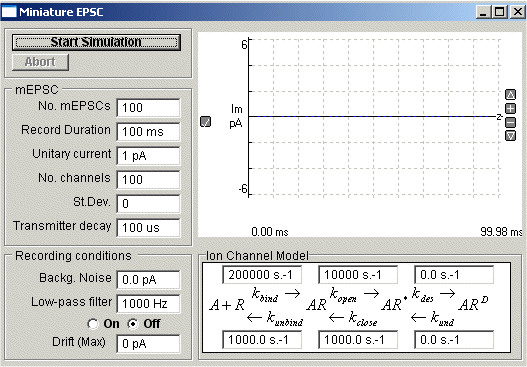Simulations > Miniature EPSC Simulation
The miniature EPSC module generates simulated miniature postsynaptic currents, exhibiting the stochastic fluctuations associated with the current flow through the population of ion channels opened by a single quantum of transmitter. The gating of a single post-synaptic ion channel is represented by a simple 4-state model. Binding of an agonist molecule (A) with receptor (R) to form an agonist-receptor complex, makes it possible for the channel to shuttle between a closed state (AR), an open state (AR*) and a closed/desensitised state (ARD).

The single-channel current time course is governed by six rate constants – rate of binding and unbinding of agonist from receptor, (kbind, kunbind) rate of channel opening and closure (kopen, kclose) and the rate of entry and exit from the desensitised state (kdes, kund). The mEPSC is generated by summing the individual single-channel current time courses, for each ion channel opened by the brief pulse of transmitter released from each vesicle (time course represented by a decaying exponential function with a time constant of 10 s.
To create a data file containing simulated mEPSCs:
Create a new data file to hold the records, by selecting
File
New
and entering the name of a new data file.
Select
Simulations
Miniature EPSCs
to open the simulation window.
Set the simulated mEPSC properties:
mEPSC: Enter the number of simulated mEPSC records to be created in the No. mEPSCs box. Enter the single-channel current amplitude for the post-synaptic ion channels in the Unitary current box. Enter the average number of ion channels activated when a quantum of transmitter is released in the No. channels box and its standard deviation in the St. Dev. Box. Enter the transmitter release decay time constant into the Transmitter decay box.
Ion Channel Model: Enter the rates constants which define the ion channel gating properties. (Note. Models which permit entry into the desensitised state (kdes>0) produce mEPSCs with biexponential decays. If kdes =0 monoexponential decays result.)
Recording Conditions: Enter the standard deviation of recording background noise in the Backg. Noise box. If low-pass filtering is to be applied to the mEPSC, select the Low-p filter On option and enter the cut-off frequency in the box. Random baseline drift can be added to each record by entering a non-zero value in the Drift (Max) box.
Click the Start Simulation button, create the simulated mEPSC current records.